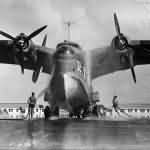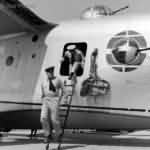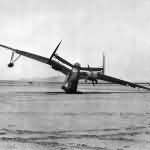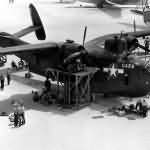PBM-3 Mariner code C-10 in flight during 1942-1943
Prototype in flight
Australian Mariner A70-12 in flight
Amphibious aircraft XPBM-5A
Martin XPBM-1 nose
XPBM-1 with fixed tail
Wrecked Mariner Iceland 19 February 1942
VP-56 was among the earliest users of the PBM-1 Mariner. The aircraft, which can be observed in this instance, features Neutrality Markings on its nose. These markings were intended to appease those who were against America’s involvement in the escalating conflict in Europe.
E8 “Belle of the Pacific” on board seaplane tender USS St. George
PBM-5 seaplane Base 1945 2
PBM-5 E2 hoisted aboard a seaplane tender
PBM-5
PBM-5 at seaplane Base 1945
PBM-3S Norfolk
PBM-3S Natal Brazil
Unarmed transport version
PBM-3S
PBM-3S Mariner A70-5 Royal Australian Air Force
PBM-3S
PBM-3D
PBM-3R 6-R-404
PBM-3R January 1943
PBM-3C NAS Banana River
Martin PBM-3C 1943
PBM-3 1942
PBM-3 rear
PBM-3 tail
Front turret
PBM-3 formation
PBM-3 Engine Work
PBM-3 takeoff
PBM-1 VP-74
PBM-1 VP-56
PBM-1 VP-56
PBM-1 VP-56
Early test flight
PBM-1 VP-55 in flight
Silver early PBM-1
Mariner Operational Training Unit
PBM-1 Argentia Bay
PBM-1 Argentia Bay
PBM-1 Argentia Bay
PBM-1 1941
PBM-1 1259
PBM-1 2 1941
PBM with Refueling Tender in Marianas
PBM plant at Baltimore
PBM NAS Coronado 1943
PBM NAS Bermuda
PBM NAS Banana River 1943 2
PBM NAS Banana River 1943
Black C428 BuNo 45428 from VPB-26 in the foreground
PBM Dry Lake near Tuscon, Arizona
JX103 at Maritime Aircraft Experimental Establishment
Radioman and navigator at work
PBM in hangar at NAS Banana River 1943
PBM Florida April 1943
PBM PTO
PBM being refueled in the Marianas in early 1945
PBM Banana River Florida March 1943
Florida 1943
PBM Alameda
NAS Guantanamo Bay
Mariner fuselage
Saipan base
Mariner with British markings
PBM-3D 2
Mariners Saipan
British Mariner JX109
Martin PBM-1 74-P-4 of the VP-74 returns to East Coast 1942
Transport Martin PBM-3R Mariner taking off 1942/43
Early PBM-1 55-P-1 of the VP55 being hoisted on board the seaplane tender, 1941
Martin PBM flight engineer station interior
Martin PBM take off with Jet Assisted Take Off (JATO) 1945
Martin PBM-5 Mariner “white 8” on beaching gear
Martin PBM-3S Mariner “12” at NAS Norfolk 1943
PBM-3S Mariner P-8 of the VP-8 on beaching gear at NAS Norfolk 1943
Plexiglass domes of machine gun turrets being readied for PBM’s
U.S. Navy crew and their Martin PBM-3D “white 37”
PBM-3C Mariners on sssembly line in Baltimore Plant 1943
Crew installs new propeller on Martin PBM at Marianas base
Early Martin PBM-1 Mariner at Norfolk 1941
Crew of downed Martin PBM-5 board life rafts off Korea 1945
Female inspector checks PBM’s de icing equipment at Glenn Martin Plant 1943
Martin PBM-5 and Coronado seaplanes at base in Marianas
PBM-3C Mariner C-10 off NAS Norfolk, Virginia 1942
Martin PBM-1 BuNo1253 of the VP-55 being hoisted on board the seaplane tender, 1941
PBM-3S of VP-211 over shoreline of Rio as they return to base 1944 2
PBM on patrol in Pacific 1944, color photo
Anti-submarine aircraft PBM-3S of the VP-8 in water at NAS Norfol, Virginia 1943
Seabees use pontoon lighter barge to move PBM-5 “C10” on Okinawa
Flying boat PBM-3S at San Diego California 1944
The XPBM-1, along with the accompanying support personnel, is getting ready for an early test flight. Support tenders are present, carrying the necessary equipment and personnel.
Early PBM-1 55-P-1 of the VP55 being hoisted on board the seaplane tender, 1941 2
PBM recsues crew of sinking PBM downed off Korea 1945
PBM-3C Mariner “C-10” off NAS Norfolk, Virginia 1942
Launching a PBM-1 at NAS Norfolk 1941
Flying boat PBM-1 BuNo 1262 in flight, 1941
PBM-1 Mariner 22 Florida 1943
PBM-3D Bunny is on beaching gear
PBM-3D flying boat with search radar housing above the forward fuselage anchored on the water
Martin PBM-5 Mariner on water
PBM-5 Mariner code E5 Okinawa
Martin PBM-3 Mariner flying boats on final assembly line
PBM-3R Mariner on a seaplane ramp 18 August 1942
PBM Mariners Saipan
PBM-3D Mariner taxiing in the waters off NAS Pensacola 25 October 1944
Martin PBM-5 Mariner Saipan
VB-2, the Mariner Operational Training Unit, was based at NAS Banana River in Florida. In this photograph, a group of two PBM-1s and PBM-3s, with different features, are captured together.
PBM patrol bomber flying boat Bunny
British PBM-3B Mariner Mk I serial JX103 of No. 524 Squadron at Oban October 1943
Martin Mariner PBM-3D Makes Dry Landing in Arizona Desert 1944
Martin PBM-5 Mariner hoisted aboard seaplane tender 1945
PBM-3 H-243 Patrol Bomber on Mission
Destroyed PBM Mariner code E4 Okinawa
Beached radar fitted PBM-5 J047 of the VPB-27
PBM Martin Mariner taking off with JATO
PBM-3S Mariners of the VP-211 over shoreline of Rio as they return to base
Martin PBM-5 Mariner code E10 from VPB-27 Patrols off Okinawa 1945
PBM-5 Martin Mariners gets overhaul on seaplane tender 1945
Destroyed PBM Mariner code E3 Okinawa
PBM-3 Mariner making a rocket assisted take off from the waters off NAS Kaneohe September 1944
PBM on the assembly floor at the Glenn L. Martin Company plant in Baltimore Maryland 1943
PBM-1 Mariner taxis in the waters off NAS San Juan Puerto Rico 16 July 1945
PBM-3 Mariner flying boat undergoing engine maintenance
Martin PBM-1 Mariner assembly line December 1940
Seaplane Tender Refuels PBM Mariner in the Marianas
PBM-5 Mariner code E2 Dinah Might – nose art
PBM-3 Mariner take-off 1942
PBM-3S Mariner dropping a depth charges
PBM-3 patrol bomber flying boat on mission
Anti-submarine PBM-3S Mariner
PBM-5 Mariner C428 with AN/APS-15 radar housing above the forward fuselage, Saipan
Black PBM-5 Mariner code J2 of the VPB-26 Okinawa
PBM-3 H-243 Patrol Bombers over Ocean
Martin PBM-3D Mariner 10
Martin PBM Mariner was designed since 1937. As the successor to the earlier construction of Consolidated PBY Catalina and P3M. The prototype has completed its first flight on February 18, 1939. Aircraft serial began to be delivered in 1941. Mariner s initially became operational during the fall of 1940 with squadrons VP-55 and VP-56, based at Norfolk, then after combining as VP-74 in mid–1941, moved to a new base in Bermuda.
Manufacturer: Glenn L. Martin Co., Baltimore, Maryland.
Total produced: 1366 (all variants)
Variants
- XPBM-1 (Model 162) prototype with BuNo. 0796
- PBM-1 (Model 162) BuNo. 1246, 1248-1266 (21 built); 2 x R-2600-6 engines and retractable floats
- XPBM-2 (Model 162) BuNo. 1247, one of the PBM-1. Experimental catapult-launched long-range strategic bomber, tested during 1941 but never placed
in production. - PBM-3 (Model 162B) BuNo.6455-6458, 6471-6498 (32 built)
- XPBM-3E (Model 162B) BuNo. 6456 – prototype with AN/APS-15 radar
- PBM-3R (Model 162B) unarmed transport version of PBM-3. 18 new build (BuNo.6459-6470, 6499-6504) + 31 converted from PBM-3.
- PBM-3C (Model 162C), Mariner GR Mk I – patrol version with twin 12,7 mm (.50 in) machine guns in nose and dorsal turrets, and single guns in tail turret and waist positions. AN/APS-15 radar in radome behind cockpit and bomb bays 2×1814 kg (2x4000lb). BuNo. 6505-6754, 01650-01673 ( 274 built)
- PBM-3B (Model 162C) ex-RAF Mariners GR Mk 1 after return to U.S. Navy
- PBM-3S (Model 162C) anti-submarine aircraft with reduced armament (top turred was removed) and increased range. Engines with coolinf fins. 94 built (6693, 01674-01728, 48125-48163) + 62 conversions.
- PBM-3D (Model 162D) patrol bomber with new engines R-2600-22 (1900 hp), increased armament (twin 12,7mm machine guns in nose, dorsal and tail turrets, plus two waist guns) and incresed armor protection. BuNo. 48124, 48164-48223, 45205- 45274, 45277-45404 (259 built).
- PBM-4 (Model 162E) – cancelled version with two Wright R-3350 2700 hp (2015 kW) engines
- PBM-5 (Model 162F) – Pratt & Whitney R-2800 engines (2100 hp, 1566 kW). Lengthened engine cowlings with new carburettor intake position. BuNo. 45275-45276, 45405-45444, 59000-59348, 84590-84789, 85136-85160, 98602-98615 ( 628 built).
- PBM-5E – AN/APS-15 radar and other electronic equipment.
- PBM-5A (Model 162G) amphibian version of PBM-5 with retractable nosewheel and main undercarriage in hull sided. New APS-31 radar with teardrop fairing. BuNo. 122067-122096, 122468-122471, 122602-122613 (36 built) + 4 conversions.
- PBM-5M – Mariner used to monitor missile tests.
- PBM-5N – all-weather variant. BuNo. 98606
- PBM-5S – lightened anti-submarine variant of PBM-5
- PBM-5S2 – improved anti-submarine aircraft with revised radar installation and huge searchlight.
- PBM-5G – PBM-5 used by Coast Guard
- XPBM-6 – concept
Powerplants
PBM-1: 2 x 1600 hp Wright R-2600-6 Twin Cyclone 14-cylinder air-cooled radial engines driving three-bladed, electric controllable-pitch metal propellers.
PBM-3D: 2 x 1900 hp Wright R-2600-22 Twin Cyclone 14-cylinder air-cooled radial engines driving three-bladed, electric controllable-pitch metal propellers.
PBM-5: 2 x 2100 hp Pratt & Whitney R-2800-22 Double Wasp 18-cylinder air-cooled radial engines driving four-bladed, electric controllable-pitch propellers.
Bibliography
- PBM Mariner in Action – Bob Smith, Perry Manley; Squadron/Signal Publications – Aircraft Number 74
- Pilot’s handbook of flight operating instructions PBM-5 airplanes
- Flying Boats and Seaplanes since 1910, The Pocket Encyclopedia of World Aircraft in Color – John W. Wood
- American Flying Boats and Amphibious Aircraft – E.R. Johnson
- Golden Age of Flying-boats, Aeroplane Collectors’ Archive – Kelsey Publishing Group 2012
- Flying boats of WWll, Aviation Archive – Kelsey Publishing Group 2015
- Wings Of Fame – The Journal Of Classic Combat Aircraft – Volume 7
- United States Navy Aircraft since 1911 – Gordon Swanborough, Peter M Bowers
- Navy Air Colors: United States Navy, Marine Corps, and Coast Guard Aircraft Camouflage and Markings, Vol. 1, 1911-1945 – Thomas E. Doll, Barkley R. Jackson; Squadron/Signal Publications 6159
- The Official Monogram U.S. Navy & Marine Corps Aircraft Color Guide, Vol 2: 1940-1949 – John M. Elliott, Monogram Aviation Publications 1989
- R. Johnson – United States Naval Aviation, 1919-1941: Aircraft, Airships and Ships Between the Wars
- Steve Ginter – Martin PBM Mariner, Naval Fighters number 97
- Richard A. Hoffman – The Fighting Flying Boat: A History of the Martin PBM Mariner







































































































































